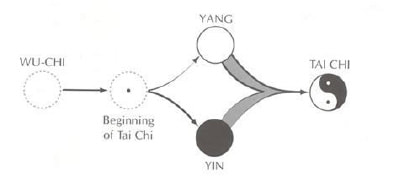|
Wu Chi and Tai Chi are interconnected concepts within Taoist philosophy, although they represent different aspects. Image from From Wu Chi evolved Tai Chi (Yin and Yang)
Wu Chi (Wuji) meaning "Ultimate Void" or "Primordial Emptiness," is the state of undifferentiated potential from which all things arise. It is often shown as an empty circle (infinity) signifying the boundless and formless state of potentiality. Tai Chi is shown as the broken circle (Yin and Yang) and represents the harmonious balance and interdependence of opposing forces. Wu Chi is an important stance in both Qigong and Tai Chi. It is the quiet time before the form begins and is rooted in Taoist philosophy, particularly the idea of harmonizing with the natural flow of the universe (Tao). The Wu Chi pose incorporates body position, breath, visualisation and mental focus. Wu Chi breathing is slow and deep and focused on breathing through the dantian. Slowing and deepening the breath helps relax both mind and body. Tai Chi, on the other hand, translates to "Supreme Ultimate" and symbolizes the dynamic interplay of Yin and Yang. In the practice of Tai Chi Chuan (Taijiquan), we seek to embody the principles of Tai Chi, which include harmony, balance, and the cultivation of Qi (vital energy). While Wu Chi is the philosophical foundation that underpins these principles, Tai Chi Chuan involves physical movements that aim to express the dynamic equilibrium of Yin and Yang in a martial arts context. Both Wu Chi and Tai Chi emphasize the integration of mind and body. Wu Chi represents the primordial state of potentiality from which we can draw upon during Tai Chi practise to achieve a state of balance, relaxation, and mindfulness. Both concepts have deeply Influenced by Chinese culture, philosophy, and martial arts. Tai Chi, in particular, has become globally recognized for its health benefits and meditative aspects, drawing upon Taoist principles of Wu Chi to promote physical and mental well-being. In essence, Wu Chi serves as the philosophical foundation underpinning the practice of Tai Chi Chuan. It emphasises the unity, balance, and interconnectedness of all things before the manifestation of dualities such as Yin and Yang. Through the practice of Tai Chi, we aim to embody these principles in both physical movements and spiritual cultivation.
0 Comments
Leave a Reply. |
AuthorRosemary Palmer is Principal Teacher with the: Moving Meditation School of Tai Chi and Qigong and Retired National Secretary of the Tai Chi Association of Australia. Archives
April 2025
Categories |
Site powered by Weebly. Managed by JustHost


 RSS Feed
RSS Feed